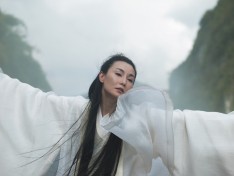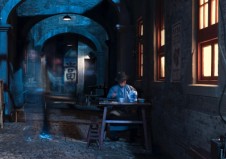Isaac Julien: Better Life (Ten Thousand Waves)

Maggie Cheung in Better Life (Ten Thousand Waves)
FILM AT REDCAT PRESENTS
Isaac Julien: Better Life (Ten Thousand Waves)
Saturday March 7, 2020, 8:30 pm
At REDCAT, 631 West 2nd Street, Los Angeles CA 90012
Co-sponsored by Los Angeles Filmforum
In person: Isaac Julien and writer/curator Mark Nash
https://www.redcat.org/event/isaac-julien-better-life-ten-thousand-waves
Note the change of day!
After co-founding Sankofa Film and Video Collective in London in 1980, and directing the cult lm Looking for Langston (1989), Isaac Julien has successfully tread a number of aesthetics and national boundaries—from film to photographs to installations—from gallery/museum spaces to the politics of immigration, race and queerness. Since 2018, he and collaborator Mark Nash have developed the Isaac Julien Lab at the University of California, Santa Cruz. They will come to REDCAT to introduce Better Life (2010), the single-channel version of one of Julien’s best-known installations, Ten Thousand Waves, inspired by the drowning of 23 Chinese undocumented cockle pickers in Morecambe Bay (northwest England). Mazu, goddess of the sea (Hong Kong screen icon Maggie Cheung), floats over the tragedy.
“A beautiful, poetic experience.” – Artforum
“Julien’s work has a particular fascination and strength, combining political commitment, an acute sensitivity to the complexities of the world’s developing global culture, and a visual approach that is lushly, swimmingly sensual. Although his films, photographic works, and multiscreen video installations emerge from no-holds barred processes of research and analysis, they appeal not just to the mind but to the body, delighting the eye.” – Glenn D. Lowry Director, The Museum of Modern Art
Tickets: $12 general; $9 for REDCAT and Current Filmforum members
Available for presale at https://web.ovationtix.com/trs/pr/1023315
Filmforum members contact us at lafilmforum@yahoo.com for the discount code.
Guests:
A key figure in the film and video workshop movement of the early 1980s, Isaac Julien is now a leading international film and video artist, producing work for cinema, television and art galleries. He was born in London in 1960, one of five children of parents who migrated to Britain from St Lucia. In 1983, while studying fine art and film at St Martin's School of Art, in collaboration with Martina Attille, Maureen Blackwood, Nadine Marsh-Edwards, and Robert Crusz, he co-founded Sankofa Film and Video Collective with dedicated to developing an independent black film culture in the areas of production, exhibition and outreach. In 1986, Julien and Blackwood directed The Passion of Remembrance (1986), which created a “visual mosaic to signify the black British experience of the 80s.” In 1989, Julien’s Looking for Langston garnered a cult following for its poetic exploration of the writings of Langston Hughes and the Harlem Renaissance, while his 1991 debut feature Young Soul Rebels won the Semaine de la Critique prize at the Cannes Film Festival. Other films include Frantz Fanon: Black Skin, White Mask (1996), BaadAsssss Cinema (2002) (on Blaxploitation films) and Derek (2008) (about fellow filmmaker Derek Jarman), among others.
In the early 1990s, Julien worked mainly in television and music video: productions from this period include a music video for Des'ree, Feel So High (1991) and a four-part series for US television, The Question of Equality (1995). He moved into gallery and museum-based work, with installation pieces including Trussed (1996), Vagabondia (2000), Fantôme Afrique (2005), WESTERN UNION: Small Boats (2007), Ten Thousand Waves (2010) and Playtime (2013). He strives to break down the barriers that exist between different artistic disciplines, drawing from and commenting on film, dance, photography, music, theatre, painting and sculpture, and uniting these to construct a powerfully visual narrative. Thematically, much of his work relates to experiences of black and gay identity, including issues of class, sexuality, immigration, as well as artistic and cultural history.
Solo exhibitions include Zeitz Museum of Contemporary Art Africa (Zeitz MOCAA), Cape Town (2017); Venice Biennale (2017); Platform-L Contemporary Art Centre, Seoul (2017); The Royal Ontario Museum, Toronto (2017); Fondation Louis Vuitton, Paris (2016); MAC Niterói, Rio de Janeiro (2016); Museo Universitario Arte Contemporáneo (MUAC), Mexico City (2016); De Pont Museum, Netherlands (2015); Art Basel (2015); Museum of Modern Art, New York (2013); Art Institute of Chicago (2013); The Bass Museum, Miami (2010); Museum Brandhorst, Munich (2009); Museum of Modern Art, Dublin (2005); Centre Pompidou, Paris (2005) and Moderna Museet, Stockholm (2005); Documenta 11, Kassel (2002).
Julien has taught extensively, holding posts such as Chair of Global Art at University of Arts London (2014-2016) and Professor of Media Art at Staatliche Hoscschule fur Gestaltung, Karlsruhe, Germany (2008 – 2016). In 2018, Julien joined UC Santa Cruz where he is the distinguished professor of the arts and is developing the Isaac Julien Lab with collaborator Mark Nash. He currently divides his time, living and working in London, England and Santa Cruz, California.
Mark Nash is an independent curator and writer. His formation was in film theory and film culture, editing Screen between 1977 and 1981. He is the author of Screen Culture Theory (Palgrave: 2007). In the 1980s he began to focus on issues of race and sexual orientation in relation to post Second World War cinema. He also worked with Isaac Julien on several projects central to which was the work of psychiatrist and theorist of decolonization Frantz Fanon. This resulted in the film Frantz Fanon Black Skin White Mask, (1996) and a conference Frantz Fanon Critical Genealogies, NYU (1996). On the basis of this work he collaborated with Okwui Enwezor on his exhibition The Short Century and Documenta 11. Most recently he has curated One Sixth of the Earth at ZKM.
Nash has also had a long-standing interest in art, world, experimental and avant-garde cinema: first in terms of the way film theory sees these cinemas as embodying debates on the relation of art and politics (which all come back to the dichotomy between notions of revolution conceived in terms of aesthetics, or of politics and ways of encompassing the two). Second in terms of revisions of art historical notions of modernism to include 20th century avant-garde cinema. This has lead to an interest in the return of the moving image into the gallery and the development of a wide range of contemporary moving image on which he has written and lectured quite widely.

Better Life (Ten Thousand Waves)
Better Life (Ten Thousand Waves)
By Isaac Julien
35mm film transferred to HD, color, 5.1 sound, 51'44''
Better Lifeis the single-channel version of British artist Isaac Julien’s most ambitious project to date, the nine-screen installation Ten Thousand Waves (2010). Poetically weaving together stories linking China’s past and present, it explores the movement of people across countries and continents and meditates on unfinished journeys. Made
over four years, the piece was filmed on location in the ravishing and remote Guangxi Province as well as in the original Shanghai Film Studios (now demolished) and various sites around Shanghai. Through formal experimentation and a series of collaborations, Julien sought to engage with Chinese culture through contemporary events, ancient myths and artistic practice. He worked with a number of leading artistic voices, including: the legendary siren of Hong Kong cinema Maggie Cheung; Jia Zhangke’s muse and main performer Zhao Tao; poet Wang Ping; master calligrapher Gong Fagen; multi-media artist Yang Fudong; cinematographer Zhao Xiaoshi; and a 100-strong Chinese cast and crew.
The film’s original musical score is by fellow east Londoner Jah Wobble and the Chinese Dub Orchestra and Maria de Alvear. The original inspiration for Ten Thousand Waves was the Morecambe Bay Tragedy of 2004, in which 23 Chinese cocklepickers died. In response to this event, Julien commissioned the poet Wang Ping to come to England and write Small Boats, a poem that is recited in the work.
Over time, Julien uncovered a symbolic body of material, which inspired him to craft a fable about the goddess Mazu (Maggie Cheung), who comes from Fujian province, the same region where the Morecambe bay cockle-pickers originated. In the tale of Yishan Island, 16th-century fishermen are lost at sea until the goddess figure leads them to safety. Using this fable as a starting point, Julien deftly draws poignant connections to the 21st-century tragedy of Chinese migrants who died struggling to survive in the north of England. Following ideas surrounding death, spiritual displacement, and the Chinese connection with “ghosts,” the film links past and present-time Shanghai. Julien employs the visual language of ghost stories: recurrent figures and images appear and disappear. Mazu’s spectral form traverses time and space, serving as a guide through interlocking strands of the work. Mirroring the goddess of the fable, a ghostly protagonist (Zhao Tao) leads viewers through the world of Chinese cinema’s golden period via the Shanghai film Studio, to a restaging by Julien of scenes from Wu Yonggang’s The Goddess (Shen Nu, 1934), and finally to the streets of modern and old Shanghai. – Adapted from a text by the Museum of Contemporary Art San Diego.
